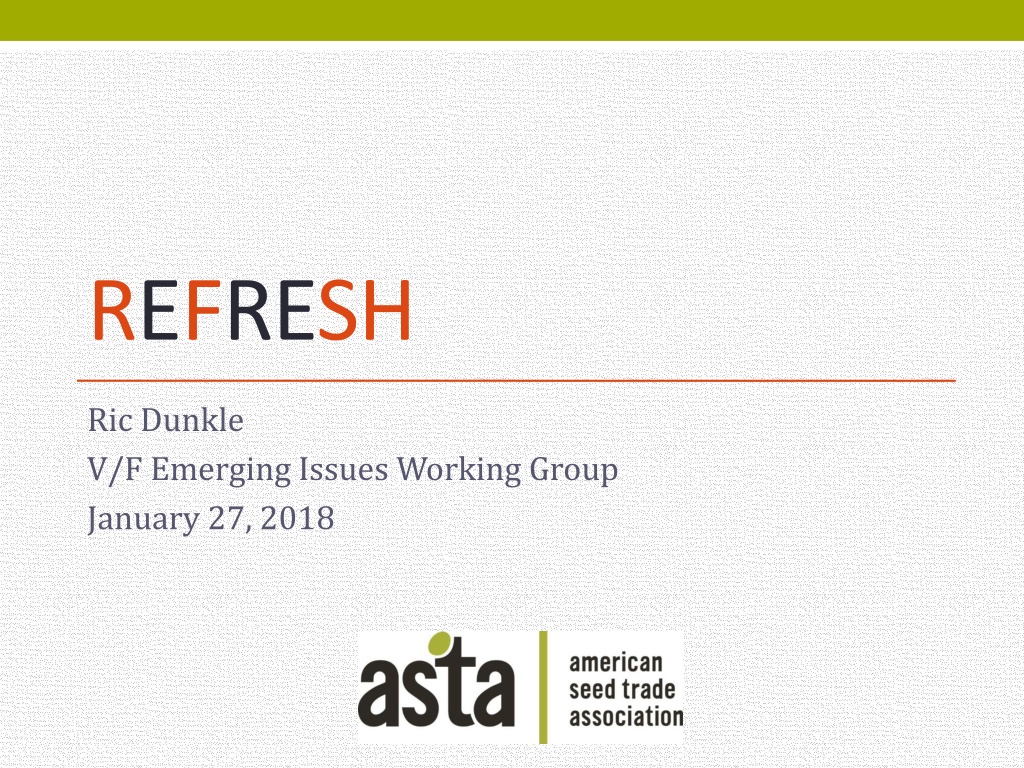Revolutionizing Seed Trade Regulations: The ReFreSH Approach
A new approach, ReFreSH, aims to enhance the efficiency of managing phytosanitary risks in international seed movements by shifting focus towards accrediting producers and production processes. This system seeks to accommodate all seed sectors and company sizes while promoting global adoption of best practices.
Download Presentation

Please find below an Image/Link to download the presentation.
The content on the website is provided AS IS for your information and personal use only. It may not be sold, licensed, or shared on other websites without obtaining consent from the author. Download presentation by click this link. If you encounter any issues during the download, it is possible that the publisher has removed the file from their server.
E N D
Presentation Transcript
REFRESH Ric Dunkle V/F Emerging Issues Working Group January 27, 2018
Regulating Seed Trade (U.S.) Traditionally seed regarded by regulators as a relatively low risk pathway so seed moved in trade with minimal import requirements Currently, most seed for planting imported into the United States requires only a phytosanitary certificate from the country of origin and port of entry inspection Phytosanitary certification on consignment by consignment basis
Why The Recent Concern About Seeds? 2013: Detection of CGMMV in California 2014: National Seed Health Summit Source: CDFA
Challenges of Regulating Seed Trade Increasingly global nature of seed industry Trend to increasing demand for documents and declarations that specific pests are absent in imported seed Providing those certifications on a consignment basis straining NPPO resources Source: Good Fruits & Vegetables
NSHAPP National Seed Health Accreditation Pilot Program Implemented 2015 Program administered through Iowa State University Voluntary program Participating seed companies voluntarily test imported seed lots Focus on testing cucumbers, melons and watermelon for CGMMV 10K lots tested; 22 positive lots detected
A New Approach- Regulatory Framework for Seed Health (ReFreSH) Risk-, science-based systems approach Aims to develop a more effective and efficient program for managing phytosanitary risk associated with international seed movements. Leverage industry best practices Promote global adoption of same system
A New Approach- Regulatory Framework for Seed Health (ReFreSH) Goals: Shift the current focus of consignment by consignment inspection and testing to a system where accreditation of producers and production processes forms the basis for phytosanitary certification Accommodate all seed sectors (vegetable, cereal, row crop, farm and lawn, flower) and all sizes of companies
ReFreSH- How it could work Companies producing and exporting seed become accredited by their NPPO NPPOs of importing countries accept accreditations as equivalent to phytosanitary certification of individual seed consignments Accreditation is basis for issuing phytosanitary certificates Compliance assured by quality management systems/audits
ISF Systems Approach WG VISION One globally accepted Systems Approach that serves as an alternative to existing pest risk management options to secure phytosanitary certification for the international movement of seed Global acceptance via IPPC 9
How do we get there? Conduct commodity PRAs Inventory current systems Establish accreditatio n criteria ReFreSH Identify mitigation measures Identify BMPs Validate via pilot(s)
Where are we now? ReFreSH Working Group APHIS, Industry, Academia, NPB Draft ReFreSH Concept paper Leveraging existing systems/practices Seed production site visits to Iowa and California QMS/BMP comparison document PRAs Spinach, Melon
Where are we now Conduct commodity PRAs Inventory current systems Establish accreditation criteria ReFreSH Identify mitigation measures Identify BMPs Validate via pilot(s)
Buckets (aka Critical Control Points) Pre-planting: Site Selection & Preparation Pre-planting: Plant & Seed Inputs Production: Pre-harvest Production: Seed Harvest Postharvest : Handling & Storage Postharvest: Conditioning & Treatment Postharvest: Seed Quality Testing Distribution & Transport
A Closer Look Accredit testing facilities/ certification programs Certify transplant facilities Pre- planting: Plant & Seed Inputs Use tested/ certified seed Transplant sanitation Use resistant or less susceptible cultivars Seed treatments Documentation
Sources Review of existing QMS and industry BMPs Guidance from international standards ISPM 11: Pest risk analysis ISPM14: Systems approaches ISPM36: Integrated measures for plants for planting ISPM 38: International movement of seed RSPM 40: Risk management
Overall Seed Production Model Lab Testing Variables - A Seed Health Test Seed Test Accuracy Lab Testing Variables - B Field Production Variables - A Seed Production Outcome Control Parameters ISHI Protocol Seed Test Accuracy Plant Operations Outcome Seed Health Test Trade Conditions Plant Operations Variables -A Trade Operations Variables Plant Operations Variables - B Disease Endemic Location Disease Endemnicity Variables
Next Steps Complete identifying mitigations and corresponding regulatory oversight activities Develop accreditation criteria for ReFreSH Complete description of ReFReSH by September 30, 2018 April 12-13: meeting with 6 countries (Chatham House rules) in Rome, Italy to discuss/promote se of systems approach internationally (USA, AUS, FR, NL, RSA, Chile) Bring NSHAPP under umbrella of ReFreSH Explore creation of pilot projects ReFreSH is still a work in progress!
Whats in it for me? To justify the ReFreSH effort there must be a demonstrated benefit to industry and regulators For industry: Faster release of product at import Reduced operational cost Harmonized import requirements For regulators: Greater phytosanitary security Greater efficiency and transparency






























